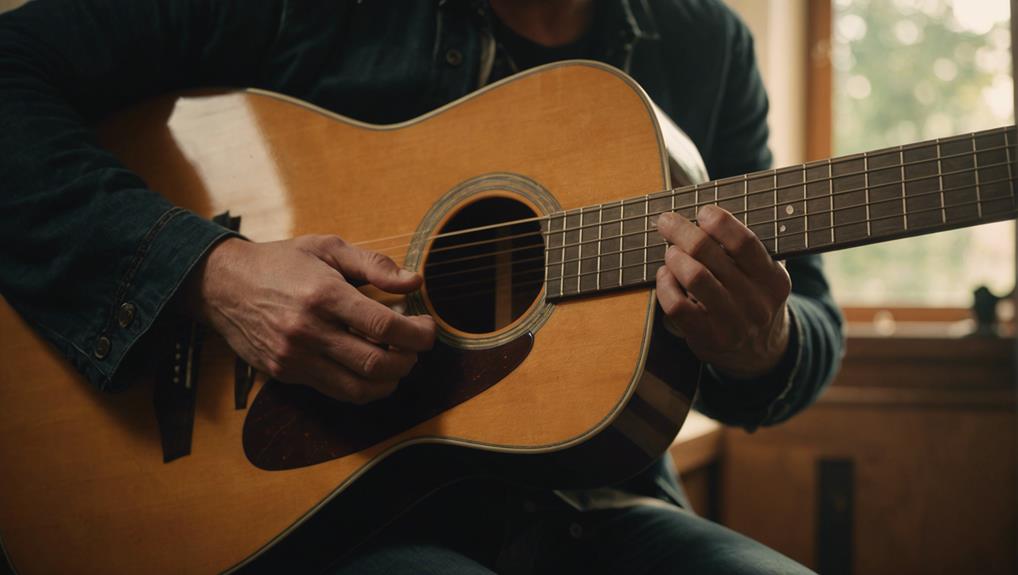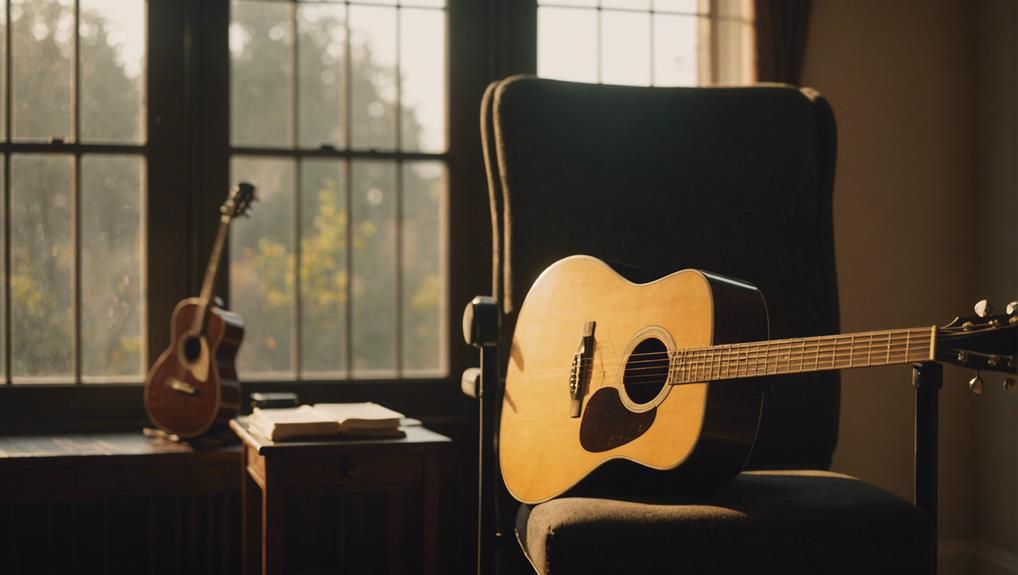When you’re about to write a guitar solo, start by understanding the key and scales of your backing music. You need to master the notes on the fretboard and get comfortable with intervals.
Focus on scales like the Minor Pentatonic and Major Pentatonic, and practice them until they become second nature. But it’s not just about scales; crafting motifs and employing dynamic expression techniques are vital.
So, how do you take these guitar training elements and create a solo that’s both engaging and musically rich? Let’s break down the steps to make sure your solo stands out.
TL-DR
- Identify the key of the backing track and relevant scales.
- Develop memorable motifs and incorporate dynamic expressions.
- Target chord tones for harmonization with chord progressions.
- Practice scales and arpeggios to ensure familiarity and fluidity.
- Use rhythmic variations and unexpected twists to maintain interest.
Understanding the Key

To start crafting your guitar solo, you need to determine the key by identifying the root note or chord progression in the backing music. Figuring out the key the song is in is essential. The key acts as your guiding star, helping you select the right scales and notes for your solo.
Begin by listening closely to the backing track. Pay attention to the root note, which is the tonal center of the song. This note often appears at the start or end of a chord progression. Recognizing this root note can point you to the key signature. For instance, if the root note is C, you might be in the key of C major or C minor.
Understanding the key is vital because it provides a framework for your solo. It ensures your notes and chords blend harmoniously with the rest of the music.
When you know the key, you can confidently build a solo that complements the song’s vibe and direction. This foundational step sets the stage for a cohesive and expressive guitar solo that enhances the overall musical piece.
Learning Notes and Intervals
Once you’ve identified the key, mastering the notes and intervals on the guitar fretboard becomes your next critical step. Understanding the notes on the fretboard is fundamental for composing compelling guitar solos. It allows you to navigate the neck with confidence and precision.
Intervals, which refer to the distance between two notes, play a pivotal role in shaping your solos. They help you create tension, release, and overall melodic interest. By memorizing common intervals like thirds, fifths, and octaves, you can craft solos that are both engaging and harmonious. These intervals form the building blocks of many iconic guitar solos, giving them their unique character and emotional impact.
Knowing the relationship between notes and intervals allows you to experiment with different melodic structures, making your solos more dynamic and expressive. Practicing scales and arpeggios will further enhance your familiarity with notes and intervals. This practice not only helps you internalize their positions on the fretboard but also develops your muscle memory, making it easier to improvise and compose.
The more you practice, the more intuitive your understanding of notes and intervals will become, setting a solid foundation for your soloing skills.
Exploring Scales and Chords

When you delve into exploring scales and chords, you’ll uncover the essential tools for crafting memorable and impactful guitar solos. The Minor Pentatonic scale, in particular, is a favorite among rock and blues guitarists due to its versatility and emotional depth. By mastering this scale, you’ll be able to create solos that resonate with listeners and convey a wide range of emotions.
To add variety to your solos, don’t hesitate to incorporate major pentatonic scales as well. These scales can introduce a brighter, more uplifting feel to your playing, making them suitable for a variety of genres. Experimenting with different keys while using pentatonic scales will help you discover unique and diverse soloing opportunities. This approach can make your solos stand out and keep your audience engaged.
Scale patterns are essential in creating interesting melodic lines and phrasing. By learning and practicing these patterns, you’ll be able to navigate the fretboard more efficiently and develop a more fluid playing style.
Additionally, when you use chords to complement your pentatonic scales, you enhance the harmonic structure of your solos, making them more dynamic and cohesive. This synergy between scales and chords is vital for crafting memorable guitar solos.
Practicing the A Minor Pentatonic
Building on your exploration of scales and chords, let’s focus on practicing the A Minor Pentatonic scale to solidify your soloing skills. This scale is fundamental in rock, blues, and pop solos, consisting of the notes A, C, D, E, and G. These five notes offer a versatile and melodic sound, making your solos both expressive and emotive.
Start by familiarizing yourself with the scale’s patterns and positions on the fretboard. Practice the A Minor Pentatonic scale in different keys to develop a deeper understanding of its layout. This will help you navigate the fretboard effortlessly during your solos. Remember, the more comfortable you’re with these notes, the more fluid and natural your solos will become.
Experiment by incorporating the scale over various chord changes. For example, try playing the A Minor Pentatonic over a progression in A minor. This practice will enhance the musicality of your solos, allowing you to create more engaging and dynamic phrases.
Crafting Motifs

To start crafting motifs, focus on repeating melodic ideas to create a memorable foundation for your solo.
Vary the rhythmic patterns to keep these ideas fresh and engaging.
Repeating Melodic Ideas
Crafting motifs involves creating distinct melodic ideas that serve as the foundation for your guitar solo. When writing solos, consider starting with short licks that you can build upon. These short, memorable phrases, or motifs, can be repeated and varied to give your solo a cohesive and engaging structure.
Repeating melodic ideas is key to making your solo memorable. When you introduce a motif, you establish a recognizable theme. By repeating this motif throughout your solo, you create a sense of familiarity for the listener. However, don’t just repeat the motif verbatim; introduce variations. Change the rhythm, pitch, dynamics, or articulation of the motif to keep it interesting and fresh.
Developing motifs adds depth to your solo. As you repeat and vary your motifs, you weave a musical narrative that’s both structured and dynamic. This technique helps in establishing a clear musical theme, making your solo more cohesive and impactful. Effective motif development can transform a good solo into a great one, ensuring that it resonates with your audience.
Rhythmic Pattern Development
When developing rhythmic patterns for your motifs, focus on creating grooves that captivate and drive your solo forward. Start by crafting short, distinct rhythmic ideas that can form the core of your motif development. These rhythmic patterns should be catchy and memorable, providing a solid foundation for your solo.
To add complexity and interest, vary the rhythms within your motifs. Experiment with syncopation, rests, and different note values to keep your audience engaged. Don’t be afraid to mix things up; a well-placed rhythmic shift can breathe new life into your solo.
Motif development isn’t just about rhythm; it’s also about how you use these rhythmic patterns to construct a cohesive musical narrative. By systematically developing these motifs, you’ll create a solo that’s both dynamic and structured. This approach allows you to connect different sections seamlessly, ensuring your solo flows naturally from one idea to the next.
Creating Variations
To create engaging variations in your guitar solo, start by altering note sequences to introduce fresh ideas.
Experiment with dynamic expression techniques to convey different emotions and textures.
Shift rhythmic patterns to keep the listener intrigued and maintain a lively flow.
Altering Note Sequences
Altering note sequences in your guitar solo can infuse your music with fresh creativity and keep listeners engaged. When you’re jamming over a backing track or crafting an improvised guitar solo, experimenting with the order of notes within a motif can lead to exciting variations.
Here are some ways to transform your note sequences:
- Inversion: Flip the sequence of notes upside down. If you’re playing a rising scale, try descending instead.
- Retrograde: Reverse the order of the notes. Play your motif backward to create an unexpected twist.
- Transposition: Shift the entire sequence up or down by a certain interval to explore new harmonic landscapes.
Incorporating these techniques can make your solos more dynamic and interesting. Imagine playing a familiar phrase but altering it slightly each time you repeat it. This not only adds variety but also keeps your audience on their toes.
Adding embellishments like slides, bends, and hammer-ons can further enhance these variations. Practice different iterations to find the most compelling and expressive options for your solo composition.
Dynamic Expression Techniques
Often, incorporating dynamic expression techniques into your guitar solo can make it more engaging and emotionally moving. One effective way to do this is by varying the rhythm of your solo. Experiment with different note durations and syncopations to create a sense of movement and unpredictability. This not only keeps your listeners intrigued but also adds depth to your performance.
String bending is another powerful technique you can use to add dynamic expression. By bending strings, you can emphasize certain notes, adding a vocal-like quality to your playing. This creates emotional peaks and valleys, making your solo more expressive.
Don’t shy away from simplifying the backing riff to emphasize your solo. Doing so can highlight your playing, making your solo stand out within the composition.
Additionally, consider the chord changes in the backing track and adjust your solo accordingly. Playing in harmony with the chords ensures a cohesive musical structure, enhancing the overall impact.
Rhythmic Pattern Shifts
Shifting rhythmic patterns in your guitar solo can instantly captivate listeners and add layers of complexity to your performance. By experimenting with rhythmic shifts, you can create dynamic variations that keep your audience engaged. Start by incorporating syncopation, which involves placing accents on unexpected beats. This technique can surprise listeners and add an element of unpredictability to your solo.
To further enhance your solos, consider these strategies:
- Triplets and Changing Time Signatures: Using triplets or altering the time signature within your solo can introduce a fresh rhythmic perspective.
- Unexpected Pauses and Accents: Adding pauses or accents at key moments can build tension and release, enhancing the emotional impact of your solo.
- Polyrhythms and Cross-Rhythms: These techniques can create unique rhythmic textures, providing contrast and depth to your playing.
Utilizing rhythmic pattern shifts strategically can transform a simple solo into a compelling musical journey. Syncopation, in particular, can break the monotony of straightforward rhythms, making your solos stand out.
Combining Motifs

Combining motifs in your guitar solo means developing and intertwining short musical ideas to create a cohesive and engaging performance. These motifs act as recurring themes that give your solo structure and unity.
To start, identify a few motifs that resonate with your main theme. Each motif should be distinct yet complementary, allowing you to blend them seamlessly.
When you’re combining motifs, don’t just repeat them verbatim. Experiment with variations in rhythm, pitch, and dynamics. This keeps your guitar solo interesting and adds emotional depth.
For instance, you might play a motif in a higher octave or alter its rhythm to match the underlying chord progression. These small changes can make a big difference in how engaging your solo becomes.
Planning is essential. Think about how each motif will flow into the next. This thoughtful integration ensures your solo doesn’t sound disjointed. Use motifs to build tension and release, guiding your listeners through a musical journey.
Skillful motif combination doesn’t just elevate your solo—it creates a memorable and impactful experience for your audience. By carefully crafting and intertwining these musical ideas, you’ll create solos that are both dynamic and cohesive.
Developing Your Solo
Building on the motifs you’ve created, developing your solo involves expanding these ideas into a full, engaging performance. Start by creating multiple motifs and variations to add depth and creativity. This will give your solo a rich, textured feel.
Experiment with rhythm and pitch variations to keep it dynamic and enthralling. This approach helps in maintaining the listener’s interest and avoids monotony.
When you write a solo, make sure it complements the harmony of the backing track. Playing along with the track will help you hear how your solo fits within the overall musical structure. This alignment is vital for making your solo sound cohesive and professional.
To effectively develop your solo, consider the following:
- Variety: Introduce different motifs and alter them to keep the solo fresh.
- Rhythmic Changes: Mix up the rhythm to add excitement and unpredictability.
- Pitch Variation: Use different pitches to create emotional highs and lows.
Focus on systematic writing to practice and refine your solo composition. Replicate the development process for additional bars, expanding and refining your composition. By doing so, you’ll craft a solo that’s not just a collection of notes but a compelling musical statement.
Planning the Progression

To effectively plan the progression of your guitar solo, start by analyzing the key and chord structure of the backing music. Determine the key by identifying the chord progressions used. This step is vital, as it sets the foundation for your solo. Understanding the relationship between notes, scales, and chords helps you create a coherent and engaging solo.
Begin by using the A minor pentatonic scale, a versatile choice that fits many styles and genres. As you play, listen to the chord changes in the backing track. Adapt your solo to fit these changes seamlessly, ensuring it complements the progression of the song. This cohesion between your solo and the underlying chords will make your solo sound intentional and well-crafted.
Ensure your solo has a clear beginning and end. This structure provides a sense of completeness and helps guide the listener through your musical idea. By carefully planning the progression of your solo, you’ll create a balanced and compelling piece that enhances the overall song.
Pay attention to the musical journey you want to take your audience on, and let the chord progressions guide your creative choices.
Adding Rhythm and Pitch Variations
After planning your progression, it’s time to add rhythm and pitch variations to make your guitar solo more engaging and expressive. Experiment with rhythmic variations by altering note durations and accents. Syncopation and off-beat accents can add complexity and interest.
For instance, instead of playing straight eighth notes, try mixing in triplets or dotted rhythms to create dynamic patterns.
Introduce pitch variations to add color and emotion to your solo. Techniques like bends, slides, and vibrato can make your notes sing. Explore different scales and modes to find unique phrases that enhance your solo’s melodic content.
For example, switching between the minor pentatonic scale and the Dorian mode can provide fresh tonal flavors.
To craft a memorable solo, combine rhythm and pitch variations effectively. Here are some tips:
- Change note durations: Alternate between long, sustained notes and short, staccato ones.
- Use articulation techniques: Incorporate bends, slides, and vibrato to add expressiveness.
- Play with syncopation: Emphasize off-beat notes for a surprising rhythmic twist.
Playing With Harmony

Delving into harmony, you can create more compelling guitar solos by experimenting with different chord progressions and their interplay with melodic lines. When you write a guitar solo, consider the key of the song and how it influences the harmony. This foundation is vital for crafting a solo that complements the underlying chords.
Start by using intervals and scales to add depth and richness to your solo’s harmonic structure. For instance, incorporating major and minor scales can provide various emotional textures to your solo. Don’t forget about arpeggios and chord tones; they’re essential for aligning your solo with the song’s harmony. Playing notes that match the chords provides a cohesive, pleasing sound.
Balance is key when you write a guitar solo. You need to find a middle ground between melodic lines and chordal accompaniment. This balance guarantees your solo is harmonically rich and engaging. Experiment with different chord progressions to see how they interact with your solo. Shifting between chords can introduce new harmonic possibilities that make your solo stand out.
Adjusting to Chord Changes
To adjust to chord changes in your solo, you need to understand the chord progressions you’re working with.
Focus on targeting chord tones and using scales effectively to match the harmony.
Understand Chord Progressions
Understanding chord progressions and adjusting your solo to match the changing chords is essential for creating a cohesive and engaging guitar solo. When you write a solo, recognizing the chord progressions in the underlying music allows you to craft melodies that naturally flow with the harmony.
Start by identifying the key changes in the progression, as this helps you adapt your soloing techniques accordingly.
To effectively adjust to chord changes, consider the following tips:
- Use chord tones: Incorporate notes that are part of the chords you’re playing over. This highlights the harmony and makes your solo sound more connected to the music.
- Experiment with scales: Different scales complement various chords. For instance, a major scale might work well over a major chord, while a minor scale suits a minor chord.
- Practice over different progressions: Enhance your ability to adjust to changing harmonies by playing over a variety of chord progressions.
Incorporating these strategies into your practice will make your solos more dynamic and engaging.
Always pay attention to how the chords change and adjust your solo to maintain a seamless progression, ensuring your playing stays cohesive with the underlying music.
Target Chord Tones
Targeting chord tones in your guitar solos helps you create melodies that sound cohesive and harmonically rich. To start, identify the chord changes in your backing track. This allows you to target relevant chord tones like the root, third, and fifth, which anchor your solo to the underlying harmony.
When the chords change, adjust your solo notes to harmonize with these new chords, ensuring a smooth and melodic shift.
Emphasizing chord tones in your solo gives it a strong connection to the backing track. For instance, hitting the root note of a chord at the beginning of a measure can provide a sense of stability. The third and fifth notes add color and depth, enhancing the emotional impact of your solo.
Practice shifting smoothly between chord tones. This maintains musical coherence and makes your solo sound intentional rather than random. Experiment with arpeggios and different chord voicings to highlight these tones. Arpeggios can break down chords into individual notes, making it easier to weave them into your solo.
Use Scales Effectively
Moving through chord changes in your solo becomes smoother when you effectively use scales that align with the underlying harmony. By adjusting your solo to fit the chord changes, you emphasize notes from the corresponding scale, creating a more cohesive and melodious sound.
As you write your solo, it’s important to utilize scales that match the chord progression. This guarantees that each note you play complements the underlying chords, enhancing the overall musicality of your performance.
To make your solos more dynamic, experiment with scale extensions and alterations. This adds depth and complexity, keeping your audience engaged. A great technique is to seamlessly shift between scales to accommodate different chords within the progression. This fluidity prevents your solo from sounding disjointed and maintains a harmonious flow.
Here are some tips to keep in mind:
- Experiment with modal interchange: Introduce new tonal colors and textures into your solo.
- Emphasize chord tones: Highlight specific notes from the scale that match the chord tones.
- Practice scale transitions: Smoothly move between different scales as the chords change.
Using Motif Development

Motif development in a guitar solo involves creating and repeating memorable musical themes to give your composition a cohesive and structured feel. By playing around with simple yet impactful motifs, you can create a strong foundation for your solo.
Start by crafting a short, catchy phrase that stands out. This phrase becomes your motif, a recognizable element that listeners can latch onto.
Once you have your motif, experiment with rhythmic and melodic variations. Change the rhythm, alter the pitch, or even play the motif in a different key. These small adjustments can make your solo more dynamic and engaging without losing its core identity.
Combining motifs strategically can also enhance your solo’s creativity, allowing you to weave a more intricate musical narrative.
Ensuring Engagement
To keep your audience engaged during your solo, vary your rhythm and pitch to capture their attention.
Use creative motif development and variations to maintain dynamic interest.
Harmonize your solo with the backing track and adapt to chord changes for a cohesive and compelling performance.
Capture Audience Attention
When crafting a guitar solo, capturing your audience’s attention right from the start is essential for ensuring their engagement. Begin by playing a short phrase that instantly resonates. This initial hook sets the stage for the rest of your solo.
To make this opening even more compelling, consider using dynamic contrasts in volume and intensity. A sudden shift from soft to loud, or vice versa, can make listeners sit up and take notice.
Incorporate unexpected elements to keep your audience guessing. Surprise them with twists and turns that deviate from predictable patterns. This could involve integrating bends, slides, or harmonics at key moments. Such techniques not only add excitement but also demonstrate your technical prowess.
Remember, the goal is to create a memorable experience for your listeners. Here are some tips to keep in mind:
- Start with a catchy short phrase: A memorable motif can draw listeners in immediately.
- Use dynamic contrasts: Varying your volume and intensity can create a dramatic effect.
- Add unexpected twists: Keep your audience on their toes with surprising elements.
Maintain Dynamic Interest
Ensuring your guitar solo maintains dynamic interest involves incorporating rhythmic variations and pitch changes to keep listeners engaged. Start by experimenting with different rhythmic patterns. Instead of sticking to a predictable rhythm, mix it up with unexpected pauses, syncopation, or faster sequences. These rhythmic variations can breathe new life into your solo, making it more compelling.
Next, focus on melodic variations. Don’t be afraid to explore different scales or modes. Changing the pitch and introducing new motifs can create a sense of journey within your solo. Using motifs and themes gives your solo a sense of continuity while still allowing room for creativity.
Introduce unexpected twists and turns. Surprise your audience with sudden key changes or unanticipated chord progressions. These elements can captivate listeners, making them keen to hear what comes next.
Balance tension and release throughout your solo. Build up to a high-tension point with fast runs or dissonant notes, then resolve it with a smooth, melodic passage. This ebb and flow keep the audience emotionally invested.
Be sure to also read our complete beginner’s guide on how to play the guitar right here.



